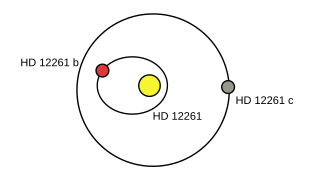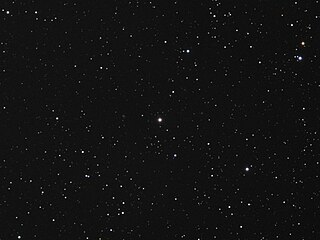14 Herculis or 14 Her is the Flamsteed designation of a K-type main-sequence star approximately 58.5 light-years away in the constellation Hercules. Because of its apparent magnitude, the star cannot be seen with the naked eye. As of 2006, it is thought that 14 Herculis has two extrasolar planets in orbit around the star.

HD 12661 is a G-type main sequence star in the northern constellation of Aries. The star is slightly larger and more massive than the Sun, with an estimated age of seven billion years. It has two known extrasolar planets.
HD 37124 is a star in the equatorial constellation of Taurus, positioned about a half degree to the SSW of the bright star Zeta Tauri. The apparent visual magnitude of this star is 7.68, which is too dim to be visible to the naked eye. It is located at a distance of 103 light years from the Sun based on parallax, but is drifting closer with a radial velocity of −23 km/s. Three extrasolar planets have been found to orbit the star.
HD 74156 is a yellow dwarf star in the constellation of Hydra, 210 light years from the Solar System. It is known to be orbited by two giant planets.

HD 49674 is a solar-type star with an exoplanetary companion in the northern constellation of Auriga. It has an apparent visual magnitude of 8.10 and thus is an eighth-magnitude star that is too faint to be readily visible to the naked eye. The system is located at a distance of 140.6 light-years from the Sun based on parallax, and is drifting further away with a radial velocity of +12 km/s.
HD 114729 is a 7th magnitude star approximately 118 ly (36.1 pc) away in the constellation of Centaurus. Like our Sun (G2V), it is a yellow dwarf. It is about the same mass as the Sun, but twice as luminous. That indicates a much greater age, perhaps over 10 billion years. HD 114729 has a co-moving companion designated HD 114729 B, with the latter having 25.3% of the Sun's mass and a projected separation of 282±10 AU.

HD 108874 is a yellow dwarf star in the constellation of Coma Berenices. It is 195 light years from Earth and has two extrasolar planets that are possibly in a 9:2 orbital resonance.

HD 128311 is a variable star in the northern constellation of Boötes. It has the variable star designation HN Boötis, while HD 128311 is the star's designation in the Henry Draper Catalogue. The star is invisible to the naked eye with an apparent visual magnitude that fluctuates around 7.48. It is located at a distance of 53 light years from the Sun based on parallax, but is drifting closer with a radial velocity of −9.6 km/s. Two confirmed extrasolar planets have been detected in orbit around this star.
14 Herculis c or 14 Her c is an extrasolar planet approximately 58.5 light-years away in the constellation of Hercules. The planet was found orbiting the star 14 Herculis, with a mass that would likely make the planet a gas giant roughly the same size as Jupiter but much more massive. It was discovered on November 17, 2005 and published on November 2, 2006, although its existence was not confirmed until 2021. According to a recent analysis, the existence of a second planet in the 14 Herculis system is "clearly" supported by the evidence, but the planet's parameters are not precisely known. It may be in a 4:1 resonance with the inner planet 14 Herculis b.
HD 114762 b is a small red dwarf star, in the HD 114762 system, formerly thought to be a massive gaseous extrasolar planet, approximately 126 light-years (38.6 pc) away in the constellation of Coma Berenices. This optically undetected companion to the late F-type main-sequence star HD 114762 was discovered in 1989 by Latham, et al., and confirmed in an October 1991 paper by Cochran, et al. It was thought to be the first discovered exoplanet
HD 72659 is a star in the equatorial constellation of Hydra. With an apparent visual magnitude of 7.46, his yellow-hued star is too faint to be viewed with the naked eye. Parallax measurements provide a distance estimate of 169.5 light years from the Sun, and it has an absolute magnitude of 3.98. The star is drifting closer with a radial velocity of −18.2 km/s.
HD 37124 b is an extrasolar planet approximately 103 light-years away in the constellation of Taurus. The planet was discovered in 1999 orbiting the star HD 37124. Based on its mass, it is most likely that this planet is a Jovian planet.
HD 37124 d is an extrasolar planet approximately 103 light-years away in the constellation of Taurus. The planet was discovered in 2005 orbiting the star HD 37124 in a long-period orbit. Based on its mass, it is considered to be a gas giant. An alternative solution to the radial velocities gives a period of 29.92 days and a minimum mass 17% that of Jupiter.
HD 72659 b is a superjovian exoplanet massing at least 3.3 MJ orbiting at 4.77 AU from the star taking 3630 days to orbit. The orbital distance range from 3.49 AU to 6.05 AU with orbital eccentricity of 0.269.
HD 128311 b is an exoplanet located approximately 54 light-years away in the constellation of Boötes. This planet orbits in an eccentric orbit about 1.1 AU from its star. The planet has minimum mass 2.19 Jupiter masses.
HD 210277 b is an extrasolar planet orbiting the star HD 210277. It was discovered in September 1998 by the California and Carnegie Planet Search team using the highly successful radial velocity method. The planet is at least 24% more massive than Jupiter. The mean distance of the planet from the star is slightly more than Earth's distance from the Sun. However, the orbit is very eccentric, so at periastron this distance is almost halved, and at apastron it is as distant as Mars is from the Sun.
HD 108874 b is a gas giant announced in 2003. The orbit lies in the star's habitable zone. It is expected that any moons orbiting this planet are enriched in carbon, and are thus quite different from the silicate-rich bodies in the Solar System. The planet is possibly in a 4 : 1 orbital resonance with HD 108874 c.
HD 114729 b is an extrasolar planet approximately 114 light years away in the constellation of Centaurus. This planet is probably slightly less massive than Jupiter. It is an "eccentric Jupiter" meaning that it does not orbit very near the star like the famous 51 Pegasi b but further out and its orbit is very oval-shaped. The mean distance from the star is 2.11 AU, about twice the Earth's distance from the Sun. At periastron, the planet is only 1.43 AU from the star, and at apoastron, the orbital distance is 2.72 AU.
HD 49674 b is an extrasolar planet located approximately 134 light-years away in the constellation of Auriga, orbiting the star HD 49674. This planet was discovered orbiting the star in 2002. The planet is a gas giant and orbits extremely close to its star, which takes only 4.95 days to revolve.



